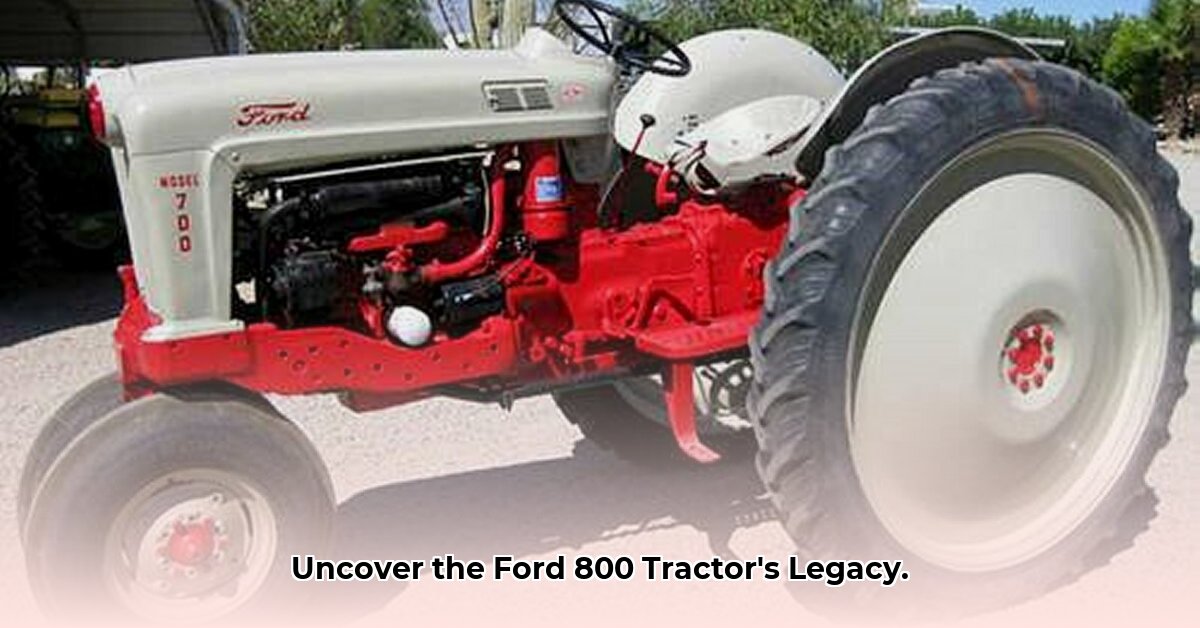
A Legacy Forged in the Fields: The Ford 800 Series
The Ford 800 series tractors, produced between 1954 and 1957, represent a pivotal moment in agricultural mechanization. More than just machines, they symbolized a shift towards greater efficiency and productivity in farming, much like the impact of the Model T on personal transportation. This article delves into the history, technical specifications, and practical aspects of owning and maintaining a Ford 800, providing a comprehensive guide for enthusiasts, collectors, and researchers alike. But why are these tractors still relevant today? Let's explore their enduring legacy. For more on Ford tractors, check out this helpful resource: Ford Tractor Info.
The Ford 800’s Rise: A Technological Leap in Farming
The mid-20th century witnessed a dramatic transformation in agriculture, fueled by advancements in mechanization. The Ford 800 emerged during this period, offering a significant improvement over its predecessors. Its robust construction, dependable performance, and relative ease of operation quickly endeared it to farmers across the country. Did the Ford 800 truly revolutionize farming practices? The evidence strongly suggests it did, contributing significantly to increased yields and altering the very landscape of agricultural work.
Key Innovations and Design Features
The Ford 800 series boasted a sturdy four-cylinder, 2.8-liter engine, delivering a respectable amount of power for its era (estimates range from 35 to 45 horsepower, depending on the model and testing method). However, early models notably lacked features becoming standard on later tractors, such as a three-point hitch and hydraulics. These additions, introduced in later 800 variants (850 and 860), underscore the rapid pace of technological advancement during this period, enhancing the tractor's versatility and operational efficiency. Consider this: the absence of these features in earlier models underscores the tractor's evolution within a short timeframe.
Understanding the Ford 800 Models: Specs and Variations
The Ford 800 series comprised several models, each with minor variations but sharing a common core design. Knowing the differences is key to finding the right parts and understanding performance characteristics. These distinctions also highlight the tractor's evolution over its production run.
| Model | Engine (liters) | Horsepower (approx.) | PTO Type | 3-Point Hitch | Hydraulics |
|---|---|---|---|---|---|
| Ford 820 | 2.8 | 35-40 | Transmission | No | No |
| Ford 850 | 2.8 | 38-42 | Live | Yes | Yes |
| Ford 860 | 2.8 | 40-45 | Live | Yes | Yes |
Note: Horsepower is an approximation and can fluctuate based on testing conditions and the tractor's maintenance history.
Owning a Ford 800: A Practical Guide
Owning a classic tractor like the Ford 800 is a unique and rewarding experience. However, it requires a practical approach and a realistic understanding of its potential challenges. Here’s a step-by-step guide to navigating ownership:
1. Sourcing Parts: The availability of parts is a primary consideration. Online communities dedicated to Ford tractors are invaluable resources. Reputable parts suppliers specializing in vintage equipment are other critical avenues.
2. Pre-Purchase Inspection: Before purchasing, a thorough mechanical inspection by a qualified mechanic is essential. This proactive approach can prevent expensive surprises and ensure the tractor’s reliability. Don't skip this step! A thorough examination can save you considerable time and money in the long run.
3. Maintenance and Repair: Regular maintenance is paramount. Oil changes, cleaning, and addressing any issues promptly are vital for longevity. Developing the skills to perform basic maintenance yourself will significantly reduce long-term costs.
4. Risk Assessment: Consider the potential risks associated with purchasing a used tractor. The cost of necessary repairs, parts availability, and potential mechanical issues are key factors to assess before purchase. Did you know that a seemingly higher purchase price might, in reality, be more cost-effective over time if the tractor is in excellent condition?
The Enduring Allure of the Ford 800: A Collector's Dream
The Ford 800 retains its appeal for collectors and enthusiasts due to a combination of factors. Its historical significance connects owners to a bygone era of farming, while its robust mechanical design offers a rewarding challenge for those with a passion for classic machinery. Moreover, the passionate community surrounding these tractors provides support and a sense of camaraderie among enthusiasts. This aspect makes ownership not just about the machine but also about joining a thriving community.
- Three Pivotal Points:
- The Ford 800 series significantly advanced agricultural technology during its production run.
- Owning a Ford 800 requires a practical approach to maintenance and parts sourcing.
- The enduring appeal of the Ford 800 stems from its historical value and the strong community of enthusiasts.